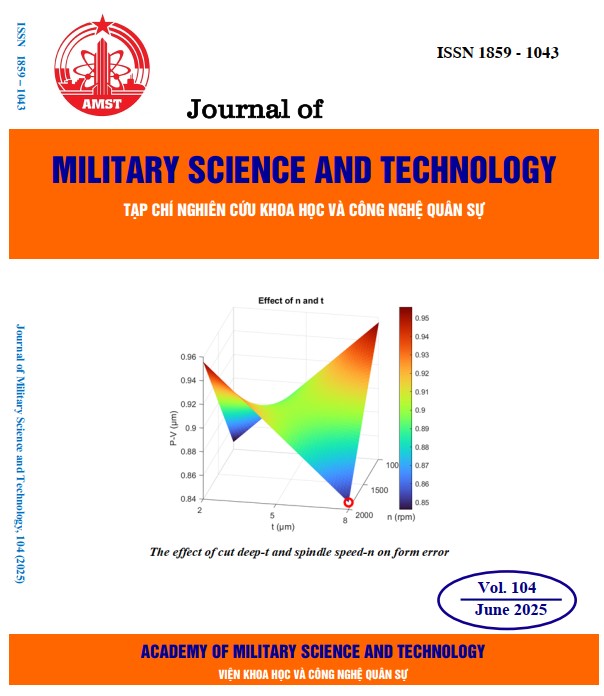Ảnh hưởng của nhiệt độ và thời gian thiêu kết đến độ cứng bề mặt của viên nén SrFe₁₂O₁₉ ép nguội: một cách tiếp cận thực nghiệm trực giao
226 lượt xemDOI:
https://doi.org/10.54939/1859-1043.j.mst.104.2025.182-191Từ khóa:
Strontium hexaferrite; Ép nguội; Thiêu kết; Độ cứng bề mặt; Nhiễu xạ tia X; Phân tích hồi quy.Tóm tắt
Nghiên cứu này khảo sát ảnh hưởng của nhiệt độ và thời gian thiêu kết đến độ cứng bề mặt và vi cấu trúc của các viên nén SrFe₁₂O₁₉ ép nguội, được sử dụng làm nam châm vĩnh cửu. Thiết kế thí nghiệm trực giao hai yếu tố đã được áp dụng để xây dựng mô hình hồi quy với độ chính xác dự đoán cao (R² = 97,23%, AICc = 55,14). Phân tích Rietveld từ dữ liệu nhiễu xạ tia X (XRD) xác nhận sự hình thành pha đơn của cấu trúc lục giác kiểu M, với kích thước tinh thể dao động từ 39,5 đến 61,8 nm và độ biến dạng vi mô phụ thuộc vào các điều kiện thiêu kết. Độ cứng bề mặt tối ưu đạt 93,63 HV ở 1000°C trong 120 phút, rất gần với giá trị dự đoán từ mô hình (95,287 HV) với độ lệch chỉ 1,74%. Kết quả này cho thấy việc kiểm soát các thông số thiêu kết đóng vai trò quan trọng trong việc giảm thiểu độ biến dạng vi mô và tối đa hóa độ cứng, cung cấp các hiểu biết thực tiễn cho quá trình xử lý gốm từ SrFe12O19 hiệu suất cao.
Tài liệu tham khảo
[1]. M. Stingaciu, M. Topole, P. McGuiness, and M. Christensen, “Magnetic properties of ball-milled SrFe12O19 particles consolidated by Spark-Plasma Sintering,” Sci. Rep., vol. 5, pp. 1–8, (2015), doi: 10.1038/srep14112. DOI: https://doi.org/10.1038/srep14112
[2]. Widyastuti, E. Kharismawati, M. Zainuri, and H. Ardhyananta, “Microstructure and magnetic properties of barium hexaferrite produced by sol gel auto combustion for radar absorber material (RAM) application,” Appl. Mech. Mater., vol. 493, pp. 656–660, (2014), doi: 10.4028/www.scientific.net/AMM.493.656. DOI: https://doi.org/10.4028/www.scientific.net/AMM.493.656
[3]. M. Stingaciu, A. Z. Eikeland, F. H. Gjørup, S. Deledda, and M. Christensen, “Optimization of magnetic properties in fast consolidated SrFe12O19 nanocrystallites,” RSC Adv., vol. 9, no. 23, pp. 12968–12976, (2019), doi: 10.1039/c9ra02440a.
[4]. K. V. Suresh, P. Fernandes, and K. Raju, “Investigation on performance and emission characteristics of diesel engine with cardanol based hybrid bio-diesel blends,” Mater. Today Proc., vol. 35, no. xxxx, pp. 378–382, (2019), doi: 10.1016/j.matpr.2020.02.691. DOI: https://doi.org/10.1016/j.matpr.2020.02.691
[5]. E. Urogiova, I. Hudec, D. Bellusova, and Bratislava, “Magnetic and Mechanical Properties of Strontium Ferrite – Rubber Composites,” Test. Meas., no. 5, pp. 224–228, (2006).
[6]. Y. C. Wong, J. Wang, and G. B. Teh, “Structural and magnetic studies of SrFe12O19 by sol-gel method,” Procedia Eng., vol. 76, pp. 45–52, (2014), doi: 10.1016/j.proeng.2013.09.246. DOI: https://doi.org/10.1016/j.proeng.2013.09.246
[7]. A. U. Rashid, P. Southern, J. A. Darr, S. Awan, and S. Manzoor, “Strontium hexaferrite (SrFe12O19) based composites for hyperthermia applications,” J. Magn. Magn. Mater., vol.344, pp. 134–139, (2013), doi: 10.1016/j.jmmm.2013.05.048. DOI: https://doi.org/10.1016/j.jmmm.2013.05.048
[8]. T. T. V. Nga, N. P. Duong, T. T. Loan, and T. D. Hien, “Key step in the synthesis of ultrafine strontium ferrite powders (SrFe12O19) by sol-gel method,” J. Alloys Compd., vol.610, pp. 630–634, (2014), doi: 10.1016/j.jallcom.2014.04.193. DOI: https://doi.org/10.1016/j.jallcom.2014.04.193
[9]. A. Wahi, N. Muhamad, A. B. Sulong, and R. N. Ahmad, “Effect of sintering temperature on density, hardness and strength of MIM Co30Cr6Mo biomedical alloy,” Funtai Oyobi Fummatsu Yakin/Journal Japan Soc. Powder Powder Metall., vol. 63, no. 7, pp. 434–437, (2016), doi: 10.2497/jjspm.63.434. DOI: https://doi.org/10.2497/jjspm.63.434
[10]. M. Aftab, A. Aftab, M. Z. Butt, D. Ali, F. Bashir, and S. S. Iqbal, “Surface hardness of pristine and laser-treated zinc as a function of indentation load and its correlation with crystallite size valued by Williamson-Hall analysis, size-strain plot, Halder-Wagner and Wagner-Aqua models,” Mater. Chem. Phys., vol. 295, p. 127117, (2023), doi: 10.1016/j.matchemphys.2022.127117. DOI: https://doi.org/10.1016/j.matchemphys.2022.127117
[11]. K. R. Sriraman, S. Ganesh Sundara Raman, and S. K. Seshadri, “Influence of crystallite size on the hardness and fatigue life of steel samples coated with electrodeposited nanocrystalline Ni-W alloys,” Mater. Lett., vol. 61, no. 3, pp. 715–718, (2007), doi: 10.1016/j.matlet.2006.05.049. DOI: https://doi.org/10.1016/j.matlet.2006.05.049
[12]. T. T. Viet Nga and N. T. Lan, “Fabrication and exchange-spring properties of SrFe12O19@Fe3O4 nanocomposites with core-shell structure,” Mater. Chem. Phys., vol.251, p. 123084, (2020), doi: 10.1016/j.matchemphys.2020.123084. DOI: https://doi.org/10.1016/j.matchemphys.2020.123084
[13]. Marian Stingaciu et al., “Optimization of magnetix properties in fast consolidated SrFe12O19 nanocrystallites,” RSC Adv., vol. 9, pp. 12968-12976, (2019), doi: 10.1039/c9ra02440a DOI: https://doi.org/10.1039/C9RA02440A
[14]. N. Kumar et al., “Optimization of Sintering Process Parameters by Taguchi Method for Developing Al-CNT-Reinforced Powder Composites,” Crystals, vol. 44, no. 9, pp. 5924–5933, (2023), doi: 10.1002/pc.27537. DOI: https://doi.org/10.3390/cryst13091352







